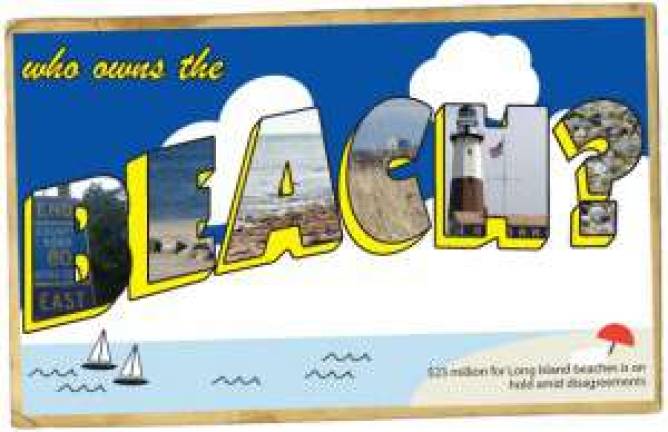Who Owns the Beach? $22 Million To Save Hamptons Beaches on Hold Amid Disagreements

The beaches of Suffolk County and the famed shores of the Hamptons are washing away, losing between one and two feet of shoreline every year. Multimillion-dollar properties, a beach economy and the dynamic coastal environment are all at risk.
Relief, in the form of sand and dredging projects, seemed to come this spring when Gov. Andrew Cuomo's administration announced it would devote $22.7 million dollars from the NY Works infrastructure fund to restoring the shoreline, leveraging $86.7 million in federal matching funds to complete the work. The infrastructure fund is a stimulus-style program designed to fast-track public works projects, in order to create jobs.
The shovel-ready appearance of these projects belies the reality: that these beach projects might not create any jobs for the remainder of Cuomo's time in office. The projects were conceived decades ago, but have been at the center of multiple fights over public access to high-priced beach property and battles in Congress over funding.
"Recommendations that serve one aspect of the community don't serve other aspects of the community, and the people in a position to make decisions are in a 'damned if you do, damned if you don't' situation," said Jeremy Samuelson, a spokesman for the Concerned Citizens of Montauk, a local group that represents Montauk area residents interested in conservation efforts, and which expressed reservations about the U.S. Army Corps of Engineers' (USACE) most recent plan to save the North Shore.
USACE's plan, the least costly option to restore the coastline, is controversial among some Suffolk County residents. It involves dredging Lake Montauk and depositing sand along the beaches. The Corps would build jetties and rock groins, considered unsightly by some locals, to anchor the sand in place.
Another big problem is an old one. And it involves money.
Some Long Island residents in East Hampton and Southampton are worried about the strings that come attached to accepting federal help rebuilding the beach.
"If we were to do the project, part of the beach that is now private would have to become public," said Chris Gardner, a spokesman for the USACE.
That could mean new public-access points every half mile along the beach, bisecting properties where homeowners would be required to sell back pieces of their land to the federal government and allow strangers to walk across their sand. In Southampton, a group of 141 wealthy homeowners proposed late last month to pay for new sand themselves with a $1.8 million bond issue, an elaborate plan to sidestep the public-beach provisions and expedite the process.
The problem becomes more severe with each passing year, especially after storms like 2011's Hurricane Irene.
"There are parts of the shoreline that are already extremely close to property," Gardner said.
At town meetings throughout the Hamptons, the plans exacerbate tensions between those whose livelihoods depend on beach tourism and fishing, and those who would rather see a more aesthetically pleasing solution than the proposed artificial rock barriers. Local fishermen say the dredging is urgently needed as commercial fishing boats increasingly become stuck in the shallow water as they try to enter the harbor.
"As a resort-based economy, we're talking about the underpinnings of our community," Samuelson said.
The Army Corps of Engineers, perhaps sensing the futility of finding local consensus on any plan, has been slow to finish a study showing how exactly they might repair the shore along 83 miles of southern coast from Fire Island to Montauk. Waiting for the study's completion, Samuelson says, "feels like waiting for Godot."
The Army Corps of Engineers blames Congress for their snail's pace.
To read the full article at City & State [click here. ]